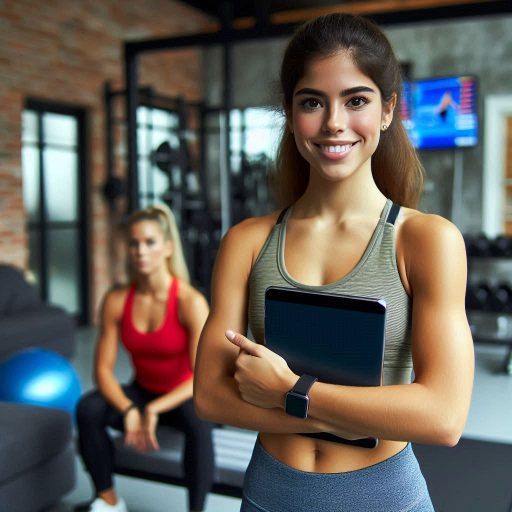Introduction
Effective communication skills are essential for personal trainers.
These skills influence how trainers interact with clients, affecting their overall experience.
Good communication fosters a strong relationship, builds trust, and enhances client motivation.
Personal trainers who communicate effectively can convey complex fitness concepts clearly.
This clarity helps clients understand their workouts and nutritional advice.
Moreover, communication plays a crucial role in client satisfaction.
When trainers listen actively, clients feel valued and heard.
This attentiveness can lead to increased client retention.
Satisfied clients are more likely to refer others and continue training.
Additionally, effective communication helps trainers assess clients’ needs accurately.
Understanding clients’ goals, limitations, and preferences allows trainers to tailor programs effectively.
This personalized approach increases the likelihood of achieving desired results.
Clients who see progress are more motivated and engaged.
On the other hand, poor communication can lead to misunderstandings.
Clients may become frustrated if trainers fail to explain exercises or provide feedback.
Such situations can hinder progress and diminish satisfaction.
In summary, effective communication is vital for personal trainers.
It enhances client relationships, satisfaction, and overall success in reaching fitness goals.
Personal trainers must prioritize developing their communication skills to foster positive experiences for their clients.
Embracing these skills ultimately benefits both trainers and clients, creating a productive and enjoyable training environment.
Transform Your Career Today
Unlock a personalized career strategy that drives real results. Get tailored advice and a roadmap designed just for you.
Start NowUnderstanding nonverbal communication
Importance of body language, facial expressions, and tone of voice in communication
Nonverbal communication plays a crucial role in how personal trainers interact with their clients.
It involves the use of body language, facial expressions, and tone of voice to convey messages and emotions.
Understanding and utilizing nonverbal cues effectively can help a trainer build rapport, establish trust, and enhance the overall communication experience with clients.
Body language is one of the most powerful forms of nonverbal communication.
It includes gestures, posture, and movement, all of which can convey subtle but essential messages to clients.
A personal trainer should be mindful of their body language to ensure they appear confident, approachable, and professional.
For example, standing with an open posture and making eye contact can signal openness and attentiveness to clients.
Facial expressions also play a significant role in nonverbal communication.
A trainer’s facial expressions can convey emotions such as empathy, enthusiasm, or encouragement, which can have a profound impact on clients’ motivation and engagement.
Smiling, nodding, and maintaining a positive facial expression can help create a positive and supportive environment during training sessions.
Tone of voice is another crucial aspect of nonverbal communication.
The way a personal trainer speaks, including their pitch, volume, and intonation, can convey different meanings and emotions to clients.
Using a warm, friendly tone of voice can help establish rapport and create a welcoming atmosphere for clients.
It’s essential to match the tone of voice with the message being communicated to ensure clarity and understanding.
Techniques for improving nonverbal communication skills
- Practice active listening: Pay attention to both verbal and nonverbal cues from clients to demonstrate empathy and understanding during conversations.
- Mirror the client’s body language: Mirroring a client’s body language can help build rapport and establish a connection based on trust and mutual understanding.
- Use positive gestures: Incorporate gestures such as nodding, smiling, and maintaining eye contact to communicate attentiveness and encouragement to clients.
- Be mindful of your posture: Maintain an open and confident posture to appear approachable and engaged during interactions with clients.
- Monitor your tone of voice: Pay attention to your tone of voice to ensure it aligns with the message you’re conveying and conveys the intended emotions effectively.
- Seek feedback: Ask for feedback from clients to evaluate how effectively you’re using nonverbal communication and make adjustments as needed to improve your skills.
Overall, mastering nonverbal communication skills is essential for personal trainers to enhance client relationships, promote effective communication, and create a positive training environment.
By understanding the importance of body language, facial expressions, and tone of voice, and practicing techniques to improve these skills, trainers can communicate more effectively and positively impact their clients’ fitness journey.
Read: How to Maintain Work-Life Balance as a Personal Trainer
Active listening skills
Active listening is an essential skill for personal trainers as it involves fully concentrating, understanding, responding, and remembering what a client is saying.
By actively listening, trainers can build trust, show empathy, and provide personalized guidance.
Here are some key points to remember when working on improving your active listening skills:
Transform Your Career Today
Unlock a personalized career strategy that drives real results. Get tailored advice and a roadmap designed just for you.
Start NowDefinition of active listening and its importance
Active listening goes beyond just hearing words – it involves fully engaging with the speaker, focusing on their words, and understanding their message.
This skill is crucial for effective communication as it helps trainers comprehend their clients’ needs, concerns, and goals.
By actively listening, personal trainers can create a supportive and trusting relationship with their clients, leading to better outcomes and long-term success.
Tips for improving listening skills
Here are some practical tips to enhance your active listening skills:
- Avoid distractions: Minimize background noise, put away electronic devices, and maintain eye contact to show your full attention.
- Practice empathy: Try to see things from your client’s perspective and acknowledge their feelings and emotions.
- Reflect back what the client has said: Paraphrasing or summarizing your client’s words shows that you are actively listening and understanding their message.
- Ask clarifying questions: If something is unclear, don’t hesitate to ask for more information to ensure you have a complete understanding.
- Provide feedback: Offer constructive feedback based on what you have heard to demonstrate that you are engaged and attentive.
Remember, active listening is a skill that can be honed over time with practice and dedication.
By improving your listening skills, you can become a more effective communicator and a better personal trainer for your clients.
Read: Continuing Education for Personal Trainers: Why It Matters

Verbal communication strategies
Effective verbal communication is essential in personal training sessions for trainers to convey information clearly and effectively to their clients.
By using appropriate verbal communication strategies, personal trainers can ensure that their clients understand instructions, feel motivated, and ultimately achieve their fitness goals.
Importance of clear and concise verbal communication in personal training sessions
Clear and concise verbal communication is crucial in personal training sessions as it helps to avoid misunderstandings and confusion.
When trainers communicate effectively, clients are more likely to follow instructions correctly, perform exercises accurately, and stay motivated throughout the session.
This leads to better results and a more positive training experience for both parties.
Techniques for effective verbal communication
Asking open-ended questions
By asking open-ended questions, trainers encourage clients to share their thoughts, feelings, and concerns.
This not only helps trainers understand their clients better but also fosters open communication and builds rapport.
Giving feedback
Providing constructive feedback is crucial in personal training sessions.
Trainers should offer feedback in a positive and supportive manner, highlighting areas of improvement and praising achievements.
This helps clients stay motivated and focused on their goals.
Using simple and clear language
Personal trainers should avoid using complex jargon or technical terms that may confuse clients.
Instead, trainers should use simple and clear language to ensure that clients understand instructions, exercises, and concepts easily.
Active listening
Effective verbal communication involves active listening.
Transform Your Career Today
Unlock a personalized career strategy that drives real results. Get tailored advice and a roadmap designed just for you.
Start NowTrainers should pay attention to their clients, show empathy, and respond appropriately to their needs and concerns.
This builds trust and strengthens the trainer-client relationship.
Body language
Verbal communication is not just about words; body language plays a significant role as well.
Trainers should maintain eye contact, use positive gestures, and display open and welcoming body language to create a comfortable and supportive environment for clients.
Repeating key points
To ensure that clients understand important information, trainers should repeat key points, instructions, and cues throughout the session.
Repetition helps reinforce learning and improves retention.
Encouragement and motivation
Verbal communication should include words of encouragement and motivation to inspire clients and keep them engaged.
Trainers can use positive affirmations, praise effort, and provide constant support to boost clients’ confidence and determination.
Overall, effective verbal communication is a cornerstone of successful personal training sessions.
By employing these techniques and strategies, trainers can communicate clearly, build strong relationships with their clients, and help them achieve their fitness goals efficiently.
Read: How to Create a Personal Trainer Business Plan
Building rapport with clients
Importance of trust and rapport for effective communication
- Establishing trust and rapport with clients is crucial for personal trainers to create a positive and supportive environment.
- It helps in fostering a strong client-trainer relationship, leading to better adherence to workout plans and achieving fitness goals.
- Building trust allows clients to feel comfortable sharing their concerns, expectations, and progress with their personal trainer.
- Effective communication is enhanced when there is a foundation of trust and rapport between the trainer and client.
Tips for developing relationships with clients
Show empathy
- Understand the challenges and goals of the clients and show empathy towards their unique situations.
- Listen actively to their concerns and provide constructive feedback and encouragement.
Be approachable
- Create an open and welcoming atmosphere where clients feel comfortable expressing themselves.
- Encourage open communication by being approachable, friendly, and non-judgmental.
Read: Best Practices for Personal Trainers During Client Sessions
Discover More: Bank Teller Job Description Explained
Handling Difficult Conversations
When working as a personal trainer, one of the key skills that can greatly impact your success is effective communication.
This not only involves being able to clearly convey instructions and information to your clients but also being able to handle difficult conversations with professionalism and empathy.
Importance of addressing conflicts or concerns with clients in a professional and constructive manner
It is essential to address issues as they arise to maintain a positive and productive relationship with your clients.
Ignoring conflicts can lead to misunderstandings and dissatisfaction, ultimately affecting client retention and your reputation as a trainer.
Strategies for navigating challenging conversations, such as staying calm and offering solutions
When faced with a difficult conversation, it’s important to remain composed and approach the situation with a problem-solving mindset.
Listen actively to your client’s concerns, acknowledge their feelings, and remain objective.
Avoid getting defensive or confrontational, and focus on finding a resolution to the issue at hand.
Transform Your Career Today
Unlock a personalized career strategy that drives real results. Get tailored advice and a roadmap designed just for you.
Start NowOffer alternative solutions or compromises that address the client’s needs while aligning with your fitness goals and principles.
By staying calm and collaborative, you can turn a challenging conversation into an opportunity to strengthen your client-trainer relationship and foster trust and respect.
Ultimately, effective communication skills are crucial for personal trainers to not only guide their clients towards their fitness goals but also to build trust, loyalty, and long-lasting relationships.
By honing your ability to communicate clearly, empathetically, and professionally, you can enhance the overall experience for your clients and differentiate yourself as a top-tier trainer in a competitive industry.
Uncover the Details: Housekeeping Jobs for Students: Part-Time Opportunities
Communication in group settings
Tips for communicating effectively with multiple clients in a group training session
When it comes to communicating effectively with multiple clients in a group training session, personal trainers need to employ various strategies to ensure clear and concise communication.
- Set clear expectations: Establish clear goals and objectives for the group training session from the beginning to ensure that everyone is on the same page.
- Use visual aids: Visual aids such as charts, diagrams, and videos can help convey information more effectively and engage participants.
- Encourage active participation: Encourage clients to ask questions, provide feedback, and engage in discussions to promote a dynamic and interactive group training environment.
Techniques for managing group dynamics
Managing group dynamics is essential for maintaining a positive and productive training session.
Here are some techniques for personal trainers to consider:
- Be observant: Pay close attention to the group dynamics and individual interactions to identify any conflicts or disruptions that may arise.
- Foster a supportive environment: Create a safe and supportive space where clients feel comfortable sharing their thoughts and feelings without judgment.
- Address conflicts promptly: If conflicts arise within the group, address them promptly and respectfully to prevent them from escalating and impacting the training session.
Conclusion
Recap of the key points discussed in the blog post
Effective communication is essential for personal trainers to build rapport with clients, understand their needs, and provide tailored workouts.
Active listening, clear instructions, and empathy are crucial components of communication skills for trainers.
Using non-verbal cues, such as body language and eye contact, can enhance communication and convey trust and understanding.
Personal trainers should continuously work on improving their communication skills to ensure better client outcomes and build lasting relationships with their clients.
Encouragement for personal trainers to continuously work on improving their communication skills for better client outcomes
By honing communication skills, personal trainers can create a positive and supportive environment for clients, leading to improved motivation and adherence to exercise programs.
Effective communication fosters trust and connection between trainers and clients, resulting in better client satisfaction and long-term success.
Personal trainers who prioritize improving their communication skills will have a competitive edge in the fitness industry and be able to positively impact their clients’ health and well-being.
[E-Books for Sale]
The Big Book of 500 High-Paying Jobs in America: Unlock Your Earning Potential
$19.99 • 500 High-Paying Jobs • 330 pages
Explore 500 high-paying jobs in America and learn how to boost your career, earn more, and achieve success!
See All 500 High-Paying Jobs of this E-Book
1001 Professions Without a Degree: High-Paying American Jobs You Can Start Now
$19.99 • 1001 Professions Without a Degree • 174 pages
Discover 1001 high-paying jobs without a degree! Unlock career tips, skills, and success strategies for just $19.99!




